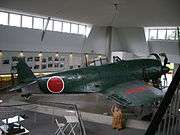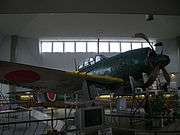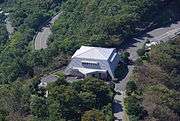Kawanishi N1K
| N1K/N1K-J | |
|---|---|
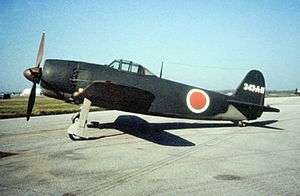 | |
| Kawanishi N1K2-J Shiden Kai | |
| Role | Fighter |
| Manufacturer | Kawanishi Aircraft Company |
| First flight | N1K1: 6 May 1942 [1] N1K1-J: 27 December 1942 [2] N1K2-J: 31 December 1943 [3] |
| Introduction | 1943 |
| Retired | 1945 |
| Primary user | Imperial Japanese Navy Air Service |
| Number built | 1,532 [4] |
|
| |
The Kawanishi N1K Kyōfū (強風 "strong wind", Allied reporting name "Rex") was an Imperial Japanese Navy floatplane fighter. The Kawanishi N1K-J Shiden (紫電 "Violet Lightning") was an Imperial Japanese Navy Air Service land-based version of the N1K. Assigned the Allied codename "George", the N1K-J was considered by both its pilots and opponents to be one of the finest land-based fighters flown by the Japanese during World War II.[5][6]
The Shiden Kai possessed heavy armament as well as surprisingly good manoeuvrability, due to a mercury switch that automatically extended the flaps during turns. These "combat" flaps created more lift, thereby allowing tighter turns. Unlike the A6M Zero, the Shiden Kai could compete against the best late-war fighters, such as the F6F Hellcat, the F4U Corsair and P-51 Mustang.[7]
Despite such capability, it suffered from unreliable engines and was produced too late and in insufficient numbers to affect the outcome of the war.
Design and development

Kawanishi's N1K was originally built as a single pontoon floatplane fighter to support forward offensive operations where no airstrips were available, but by 1943 when the aircraft entered service, Japan was firmly on the defensive, and there was no more need for a fighter to fulfil this role.
The requirement to carry a bulky, heavy float essentially crippled the N1K against contemporary American fighters. Kawanishi engineers, however, had proposed in late 1941 that the N1K would be the basis of a formidable land-based fighter too, and a land-based version was produced as a private venture by the company. This version flew on 27 December 1942, powered by a Nakajima NK9A Homare 11 radial engine, replacing the less powerful Mitsubishi MK4C Kasei 13 of the N1K. The aircraft retained the mid-mounted wing of the floatplane, and combined with the large propeller necessitated a long, stalky main landing gear. A unique feature was the aircraft's combat flaps that adjusted their angle in response to acceleration; thus freeing up the pilot's concentration and reducing the chance of stalling in combat. The N1K did have a vice: If handled roughly, it could easily enter an unrecoverable spin. Its flight characteristics were treacherous and required an experienced pilot.[8]
The Nakajima Homare was powerful, but had been rushed into production before it was sufficiently developed, and proved troublesome. Another problem was that, due to poor heat treatment of the wheels, their failure on landing would result in the landing gear being torn off. Apart from engine problems and the landing gear the flight test program showed that the aircraft was promising. Prototypes were evaluated by the Navy, and since the aircraft was faster than the Zero and had a much longer range than the Mitsubishi J2M Raiden, it was ordered into production as the N1K1-J, the -J indicating a land-based fighter modification of the original floatplane fighter.
Only four days after the Shiden's first test flight, a complete redesign was begun, the N1K2-J. The new design addressed the N1K1-J's major defects, primarily the mid-mounted wing and long landing gear. The wings were moved to a low position, which permitted the use of shorter, conventional undercarriage, the fuselage was lengthened, the tail redesigned, and the whole aircraft was made much simpler to produce, with over a third of the parts of the Shiden. Construction materials involved the use of non-critical materials.[9] The redesign was approximately 250 kg (550 lb) lighter, faster and more reliable than the previous N1K1 version. Since there was no alternative, the Homare engine was retained, even though its reliability problems had not been fully corrected. A prototype flew on 1 January 1944 and after completing Navy trials in April, the N1K2-J was rushed into production. The variant was named the "Shiden-Kai" (紫電改), Kai standing for Modified.
Operational history
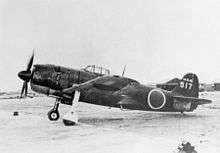
The N1K1 entered service in early 1944 and proved highly effective against American fighters. The Kawanishi was among the few Japanese fighters that could stand up to the best enemy types, including Hellcats and Corsairs. In the hands of aces, the Shiden could even outfly its American opponents. In February 1945, Lieutenant Kaneyoshi Muto, flying a N1K2-J as part of a group of at least 10 expert Japanese pilots, faced seven U.S. Navy Hellcats of VF-82 in the sky over Japan. His group shot down four Hellcats with no loss to themselves.[10] After the action, reporters fabricated a story in which Muto was the sole airman facing 12 enemy aircraft.[11] However, a close friend of Lieutenant Kaneyoshi Muto, ace pilot Saburō Sakai, states in his autobiography that the one versus twelve combat did take place, but with Muto at the controls of a Zero fighter.[12]
The N1K1-J aircraft were used very effectively over Formosa, the Philippines and later, Okinawa. Before production was switched to the improved N1K2-J, 1,007 aircraft were produced, including prototypes.
Problems resulted in very few N1K2-J aircraft being produced, but the Shiden-Kai proved to be one of the best "dogfighters" fielded by either side. Along with high speed, the fighters were very agile with a roll rate of 82°/sec at 386 km/h (240 mph). Their weaponry, comprising four 20 mm cannons in the wings, was highly effective. As a bomber interceptor, the N1K2-J was less successful, hampered by a poor rate of climb and reduced engine performance at high altitude.[13][14]
343 Kōkūtai

Due to production difficulties and damage caused by B-29 Superfortress raids on Japanese factories, only 415 fighters were produced. Consequently, N1K2-J fighters were mainly issued to elite units like the IJN 343rd Air Group (343 Kōkūtai Naval Fighter Group), commanded by Minoru Genda, which was constituted on 25 December 1944. The new 343rd Kōkūtai consisted of the best pilots, including Muto. The unit was issued the best equipment available and was also equipped with the new Nakajima C6N Saiun, codenamed "Myrt" long-range reconnaissance aircraft. On 18 March 1945, one of the "Myrts"' managed to spot U.S. carriers en route to Japan.
The following morning, 343 Kōkūtai's Shidens intercepted 300 American aircraft. Many of the 343 Kōkūtai Shiden force were N1K2s. When the Shidens encountered VBF-17 Hellcats, three aircraft were lost on both sides in the initial attack; one Hellcat and two Shiden were shot down by enemy ground fire, two fighters collided in mid-air, and one Hellcat crashed while trying to land. Then the other Shiden dove on the Hellcats, downing another one. In the end, the 407 Hikōtai lost six fighters versus downing eight VBF-17 Hellcats.

In another encounter with VBF-10 Corsairs, two of the Corsairs were separated from the main formations, and then attacked by 343rd Shidens. Four N1K2s were shot down and the Corsairs managed to return to their carrier, USS Bunker Hill. An opportunity for revenge came when VFM-123 Corsairs were surprised by Shidens, initially mistaken for Hellcats. A 30-minute aerial duel ensued in which three Corsairs were shot down and another five were damaged. Three other F4Us which had landed on carriers were so heavily damaged that they had to be pushed into the sea. Of the 10 Japanese aircraft the Americans claimed, not one was effectively downed. Two Shidens however, were shot down at landing by Hellcats of VF-9. Many other Shidens were destroyed by American fighters over another airfield, where they tried to land because they were low on fuel. At the end of the day, 343° declared 52 victories, U.S. fighters 63. The actual losses were 15 Shidens and 13 pilots, a "Myrt" with its three-man crew, and nine other Japanese fighters. The U.S. also had heavy losses, with 14 fighters and seven pilots, and 11 other attack aircraft.
Five days later, an unofficial award was sent to 343 Kōkūtai for the valour shown on 19 March. On 12 April 1945 another fierce battle involved 343°, during Kikusui N.2. The Japanese scored several victories but suffered 12 losses out of 34 machines. On 4 May, another 24 Shidens were sent in Kikusui N.5.
In every case, the Shiden, especially the Kai version, proved to be a capable dogfighter with a great combination of firepower, agility and a rugged structure. The premier unit flying the Shiden, 343 Kōkūtai, remained operational until the overwhelming unit losses led to its eventual retirement. The 343rd was disbanded on 14 August 1945, when the Emperor ordered surrender.
Variants
- N1K1 Kyofu
- N1K1: Standard type as floatplane, which was used from early 1943.
- N1K2: Reserved name for an intended model with larger engine, not built.
- N1K1-J Shiden
- N1K1-J Prototypes: development of fighter hydroplane N1K1 Kyofu, with 1,820 hp Homare 11 engine.
- N1K1-J Shiden Model 11: Navy Land Based Interceptor, first production model with 1,990 hp Homare 21 engine and revised cover, armed with two 7.7 mm Type 97 machine guns and two 20 mm Type 99 cannons. Modified total-vision cockpit.
- N1K1-Ja Shiden Model 11A: without frontal 7.7 mm Type 97s, only four 20 mm Type 99s in wings.
- N1K1-Jb Shiden Model 11B: similar to Model 11A amongst load two 250 kg bombs, revised wing weapons.
- N1K1-Jc Shiden Model 11C: definitive fighter-bomber version, derived from Model 11B. Four bomb racks under wings.
- N1K1-J KAIa Experimental version with auxiliary rocket. One Model 11 conversion.
- N1K1-J KAIb Conversion for dive bombing. One 250 kg bomb under belly and six rockets under wings.
- N1K2-J Shiden-KAI
- N1K2-J Prototypes: N1K1-Jb redesigned. Low wings, engine cover and landing gear modified. New fuselage and tail, 8 built.
- N1K2-J Shiden KAI Model 21: Navy Land Based Interceptor, first model of series with a Nakajima Homare 21 engine.
- N1K2-Ja Shiden KAI Model 21A: Fighter-bomber version. Four 250 kg bombs.
- N1K2-K Shiden Kai Rensen 1, Model A: Fighter Trainer, modified from N1K-J Series with two seats, operative or factory conversions.
- Further variants
- N1K3-J Shiden KAI 1, Model 31: Prototypes: Engines displaced to ahead, two 13.2 mm Type 3 machine guns in front, 2 built.
- N1K3-A Shiden KAI 2, Model 41: Prototypes: Carrier-based version of N1K3-J, 2 built.
- N1K4-J Shiden KAI 3, Model 32: Prototypes: 2,000 hp Homare 23 engine, 2 built.
- N1K4-A Shiden KAI 4, Model 42: Prototype: Experimental conversion of N1K4-J example with equipment for use in carriers, 1 built.
- N1K5-J Shiden KAI 5, Model 25: High-Altitude Interceptor version with Mitsubishi HA-43 (MK9A) with 2,200 takeoff hp, project only.
Production
| N1K1 Production: Kawanishi Kokuki K.K.[15] | |||||||||||||
| Year | |||||||||||||
|---|---|---|---|---|---|---|---|---|---|---|---|---|---|
| Jan. | Feb. | Mar. | Apr. | May | June | July | Aug. | Sept. | Oct. | Nov. | Dec. | Annual | |
| 1942 | 1 | 0 | 1 | 0 | 1 | 3 | |||||||
| 1943 | 2 | 1 | 0 | 1 | 0 | 0 | 5 | 8 | 9 | 11 | 13 | 15 | 65 |
| 1944 | 9 | 10 | 10 | 29 | |||||||||
| Total | 97 | ||||||||||||
- First prototype completed in April 1942, and made its maiden flight on 6 May 1942.[1]
- Pre-production started with eight prototypes and service trials aircraft completed from August 1942 to December 1942, and with a further five, in the following year.[16]
| N1K1-J Production: Kawanishi Kokuki K.K.[15] | |||||||||||||
| Year | |||||||||||||
|---|---|---|---|---|---|---|---|---|---|---|---|---|---|
| Jan. | Feb. | Mar. | Apr. | May | June | July | Aug. | Sept. | Oct. | Nov. | Dec. | Annual | |
| 1943 | 4 | 6 | 11 | 14 | 16 | 20 | 71 | ||||||
| 1944 | 17 | 40 | 65 | 93 | 17 | 71 | 90 | 92 | 106 | 100 | 82 | 51 | 824 |
| 1945 | 24 | 30 | 30 | 15 | 7 | 6 | 112 | ||||||
| Total | 1,007 | ||||||||||||
- Pre-production started with nine prototypes and service trials aircraft completed from July 1943 to Aug. 1943.[4]
| N1K2-J Production: Kawanishi Kokuki K.K.[15] | |||||||||||||
| Year | |||||||||||||
|---|---|---|---|---|---|---|---|---|---|---|---|---|---|
| Jan. | Feb. | Mar. | Apr. | May | June | July | Aug. | Sept. | Oct. | Nov. | Dec. | Annual | |
| 1943 | 1 | 1 | |||||||||||
| 1944 | 1 | 1 | 1 | 2 | 1 | 1 | 3 | 2 | 1 | 6 | 7 | 31 | 67 |
| 1945 | 35 | 47 | 58 | 80 | 81 | 20 | 12 | 5 | 338 | ||||
| Total | 406 | ||||||||||||
- Pre-production started with eight prototypes and service trials aircraft completed from Dec. 1943 to May. 1944.[4]
| Total Production: | |
| According to USSBS Report: 1,509 [15] | Figure includes: 97 N1K1, 1,007 N1K1-J and 406 N1K2-J builds. |
| According to Francillon: 1,532 [4] | Figure includes: 97 N1K1, 1,007 N1K1-J and 423 N1K2-J + K builds, with 2 N1K3-J, 2 N1K4-J, 1 N1K4-A prototypes. |
Survivors
At least three Shiden Kai aircraft survive in American museums. One is at the National Museum of Naval Aviation in Pensacola, Florida.
The second N1K2-Ja (s/n 5312), a fighter-bomber variant equipped with wing mounts to carry bombs, is on display in the Air Power gallery at the National Museum of the United States Air Force, at Wright-Patterson Air Force Base near Dayton, Ohio. This aircraft was displayed outside for many years in a children's playground in San Diego, suffering considerable corrosion, and had become seriously deteriorated. In 1959 it was donated to the Museum through the cooperation of the San Diego Squadron of the Air Force Association.[17] In October 2008 the aircraft was returned to display following an extensive eight year restoration. Many parts had to be reverse engineered by the Museum's restoration staff. Four different aircraft serial numbers were found on parts throughout the airframe, indicating reassembly from three different wrecks brought back to the U.S. for examination, or wartime assembly or repair from parts obtained from three different aircraft. Serial number 5312 was found in the most locations, and is the number now cited. The N1K2-Ja is painted as an aircraft in the Yokosuka Kōkūtai, an evaluation and test unit.[18]
The third example is owned by the National Air and Space Museum but was restored by the Champlin Fighter Museum at Falcon Field, Mesa, Arizona, in return for the right to display the aircraft at Falcon Field for 10 years after restoration. It currently is on display at the National Air and Space Museum's Steven F. Udvar-Hazy Center [19]
An authentic Shiden-Kai from the 343 squadron is displayed at a local museum in Shikoku, Japan. After the aircraft was damaged in battle, its pilot landed on July 24, 1945 in the waters of the Bungo Channel, but he was never found; by the time of the aircraft's recovery from the seabed in the 1970s, he could be identified only as one of six pilots from the 343 squadron who disappeared that day. Photographs of the six—including Takashi Oshibuchi, commander of the 701 Hikōtai, and Kaneyoshi Muto—are displayed under the aircraft engine.
Gallery
The 343 Kōkūtai's Shiden-Kai, discovered on November 18, 1978 in Jyoen Hisayoshi Bay. The aircraft is displayed at Nanreku Misho Koen, Ehime Prefecture, Japan.[20] It is possibly that the one was flown by ace-pilot Kaneyoshi Muto.
Specifications (N1K1-J)
Data from TAIC 107 A1 Report[21]
General characteristics
- Crew: 1
- Length: 9.3 m (30 ft 7 in)
- Wingspan: 12.0 m (39 ft 4 in)
- Height: 3.9 m (13 ft 0 in)
- Wing area: 23.5 m2 (253 ft2)
- Empty weight: 2,656 kg (5,855 lb)
- Loaded weight: 4,000 kg (8,820 lb)
- Max. takeoff weight: 4,860 kg (10,710 lb)
- Powerplant: 1 × Nakajima Homare NK9H radial engine, 1,850 hp (1,380 kW)
Performance
- Maximum speed: 658 km/h (408 mph)
- Range: 1,716 km / 2,395 km (1,066 mi; 1,488 mi (2,395 km) ferry)
- Service ceiling: 10,800 m (35,500 ft)
- Rate of climb: 20.3 m/s (4065 ft/min)
- Wing loading: 166 kg/m2 (34 lb/ft2)
- Power/mass: 0.305 kW/kg (0.226 hp/lb)
Armament
- 4× 20 mm Type 99 Model 2 Mk 4 cannon in wings. 200 rounds per gun (up from 100 rounds per gun internally and 70 rounds per gun in underwing boots for the early N1K1-J). The 20×101 mm round had an effective range of 1,000 m (3,280 ft) and a muzzle velocity of 700 m/s (2,297 ft/s). The 128 g shell had 6-8% HE. Rate of fire was about 500 rounds/min per gun. The guns were harmonized to converge at 200 m (656 ft).
- 2× 250 kg (551 lb) bombs
- 1× 400 L (105 gal) drop tank
See also
- Aircraft of comparable role, configuration and era
- Focke-Wulf Fw 190
- Grumman F6F Hellcat
- Kawasaki Ki-100
- Lavochkin La-7
- Mitsubishi J2M
- Nakajima Ki-84
- North American P-51 Mustang
- Republic P-47 Thunderbolt
- Related lists
- List of aircraft of Japan during World War II
- List of aircraft of World War II
- List of fighter aircraft
- List of military aircraft of Japan
References
Notes
- 1 2 Francillon, 1979, p. 318
- ↑ Francillon 1979, p. 321.
- ↑ Francillon 1979, p. 325.
- 1 2 3 4 Francillon, 1979, p. 329
- ↑ Francillon 1971, p. 58.
- ↑ Francillon 1979, p. 323.
- ↑ "Fact Sheets: Kawanishi N1K2-Ja Shiden Kai." National Museum of the US Air Force. Retrieved: 23 November 2015.
- ↑ Sakai, Saburo (1957). Samurai. p. 304. ISBN 950-15-0163-9.
- ↑ Green 1960, p. 114.
- ↑ Angelucci and Matricardi 1978, p. 171.
- ↑ Tillman 2010, p. 117.
- ↑ Sakai, Saburo (1957). "31". Samurai. p. 321. ISBN 950-15-0163-9.
- ↑ Francillon 1971, pp. 57–58.
- ↑ Francillon 1979, p. 325.
- 1 2 3 4 USSBS, Appendix C., p. 12-13
- ↑ Francillon, 1979, p. 319
- ↑ United States Air Force Museum Guidebook 1975, p. 48.
- ↑ Werneth 2008, p. 18.
- ↑ National Air and Space Museum, Kawanishi N1K2-Ja Shiden Kai
- ↑ Pacific Wrecks, IJN 343 Kōkūtai, N1K2-J Model 21
- ↑ Archives of M. Williams, TAIC 107 A1 Report: George 11
Bibliography
- Angelucci, Enzo and Paolo Matricardi. World Aircraft: World War II, Volume II (Sampson Low Guides). Maidenhead, UK: Sampson Low, 1978. ISBN 0-562-00096-8.
- Francillon, PhD., René J. Japanese Aircraft of the Pacific War. London: Putnam & Company Ltd., 1970. second edition 1979. ISBN 0-370-30251-6.
- Francillon, PhD., René J. Kawanishi Kyofu, Shiden and Shiden Kai Variants (Aircraft in Profile 213). Windsor, Berkshire, UK: Profile Publications Ltd., 1971.
- Galbiati, Fabio. "Battaglia Aerea del 19 Marzo su Kure.(in Italian)." Storia Militare magazine, Albertelli edizioni, N.166, July 2007.
- Green, William. Famous Fighters of the Second World War. Garden City, NY: Doubleday & Company, 1960.
- Green, William. Warplanes of the Second World War, Volume Three: Fighters. London: Macdonald & Co. (Publishers) Ltd., 1961 (seventh impression 1973). ISBN 0-356-01447-9.
- "Corporation Report III: Kawanishi Aircraft Company, Ltd." United States Strategic Bombing Survey Aircraft Division., Washington, D.C. 1947.
- Koseski, Krystian. Kawanishi N1K1/N1k2-J "Shiden/Kai" (in Polish). Warszawa, Poland: Wydawnictwo Susei, 1991. ISBN 83-900216-0-9.
- Mondey, David. The Hamlyn Concise Guide to Axis Aircraft of World War II. London: Bounty Books, 2006. ISBN 0-7537-1460-4.
- Sakaida, Henry. Imperial Japanese Navy Aces, 1937-45. Botley, Oxford, UK: Osprey Publishing, 1998. ISBN 1-85532-727-9.
- Sakaida, Henry and Koji Takaki. Genda's Blade: Japan's Squadron of Aces, 343 Kōkūtai. Hersham, Surrey, UK: Classic Publications, 2003. ISBN 1-903223-25-3.
- Tillman, Barrett. Whirlwind: The Air War Against Japan, 1942–1945. New York: Simon & Schuster, 2010. ISBN 978-1-41658-441-4.
- United States Air Force Museum Guidebook. Wright-Patterson AFB, Ohio: Air Force Museum Foundation, 1975.
- Werneth, Ron. "Rebirth of a Forgotten Japanese Navy Fighter." Flight Journal, Volume 13, Number 3, June 2008.
External links
| Wikimedia Commons has media related to Kawanishi N1K. |
- TACI 107A1 Report "George 11"
- Kawanishi N1K2-Ja Shiden Kai (George) – National Museum of the United States Air Force
